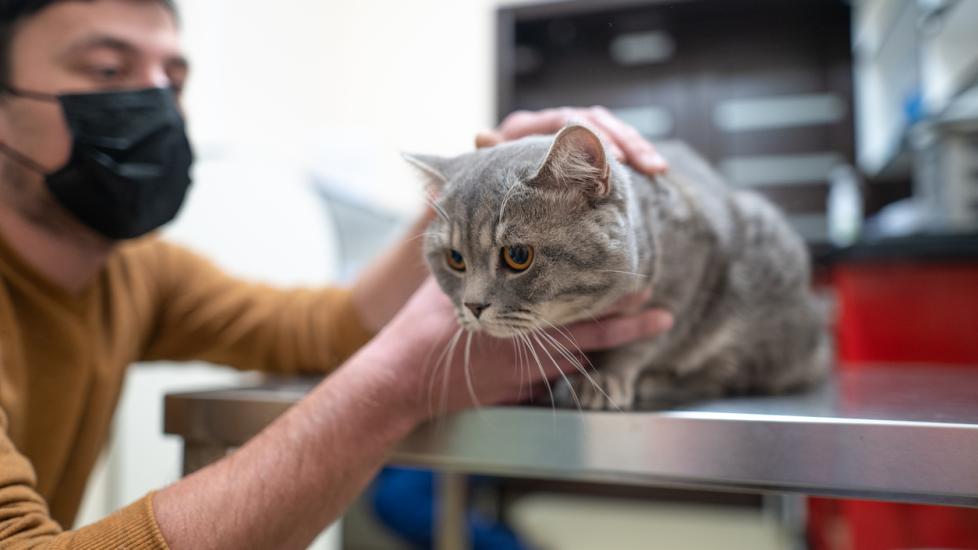Infectious Arthritis (Septic Arthritis) in Cats
What Is Infectious Arthritis (Septic Arthritis) in Cats?
Infectious arthritis in cats is a type of arthritis caused by bacteria (or some other infectious agent) entering the joints, which results in painful inflammation. This is different from noninfectious arthritis, which, for example, can be caused by the erosion of cartilage between joints (osteoarthritis) or by an autoimmune disease (rheumatoid arthritis).
Infectious arthritis in cats most commonly affects the wrist (carpus), ankle (hock), knee, and the hip joints. It is often due to an infection that spread from another part of the body. When an infectious agent enters a joint, it damages both the bone and the cartilage and can also affect other structures in the area, namely ligaments, tendons, and muscle.
While infectious arthritis is common in dogs, it is rare in cats. It can affect a single joint or multiple joints (called polyarthritis). In general, this condition is not contagious among pets nor can it be shared with people.
This type of arthritis is not an immediately life-threatening emergency, but your cat should be examined by her veterinarian as soon as possible if any signs develop, such as limping. The chances for recovery increase the faster treatment can begin.
Symptoms of Infectious Arthritis (Septic Arthritis) in Cats
The main signs of infectious arthritis include heat, swelling, and pain in one or more joints. Signs can present either as an acute (rapid) or chronic (gradual) process. In addition, septic arthritis can cause:
-
Decreased range of motion
-
Limping, lameness
-
Lethargy
-
Stiff gait
-
Fever
-
Decreased or lack of appetite
Causes of Infectious Arthritis (Septic Arthritis) in Cats
Any trauma that punctures a joint, such as a wounds or even a surgical procedure done on a joint, can result in infectious arthritis. The regular non-infectious arthritic process, osteoarthritis, and even joint injections to treat it can cause infectious arthritis.
Infection occurs when foreign material, such as viruses, bacteria, and funguses, enter the joint space. Some causes include:
-
Feline calicivirus and fungal organisms
-
Cats with compromised immune systems, or those taking immune-suppressing medications
-
Chronic conditions such as diabetes mellitus
-
Blood-borne infections, which can travel from the blood and infect the joint
How Veterinarians Diagnose Infectious Arthritis (Septic Arthritis) in Cats
If your vet suspects your cat has infectious arthritis, they will perform a complete physical exam, take a thorough history, including asking about past injuries and illnesses that could have initiated the arthritis.
They will take a blood sample to look for evidence of infection and/or inflammation. In early cases, the vet may see an increased amount of joint fluid on an x-ray of the affected limb as an indication of a current infection.
X-rays are also helpful in chronic or long-term cases to reveal signs of degenerative joint disease (DJD), such as changes to the bones or irregular joint spaces. An arthrocentesis, or sampling of the joint fluid, will also be performed to look for infection and inflammatory cells. The fluid will be cultured to determine what infectious agent (bacteria, virus, or fungus) is present. The fluid culture will also be used to determine the best medications to treat the specific infection. Serologic blood testing (which checks for antibodies in the blood) can be done to look for evidence of tick-borne disease.
Treatment of Infectious Arthritis (Septic Arthritis) in Cats
If your cat has been diagnosed with infectious arthritis, your vet will recommend hospitalizing your cat. She will be treated with IV antibiotics and injectable pain medications until comfortable and stable enough to continue to be treated at home. IV fluids and other supportive care will be provided to help reduce fever and stimulate appetite.
In some cases, it is possible that your vet might want to lavage the affected joint. This procedure will flush the joint with a sterile solution to help minimize joint damage. In severe cases, the patient will require surgery to open the joint, remove any abnormal tissue, and lavage the area to facilitate the healing process.
Recovery and Management of Infectious Arthritis (Septic Arthritis) in Cats
If your cat’s condition is diagnosed within 24-48 hours, her response to antibiotic therapy should result in a good recovery. Once your cat is home after the diagnosis and stabilization, your vet will usually recommend long-term management, such as icing and rest.
Icing the joint helps increase blood flow and decrease inflammation. Your vet will recommend that you restrict your cat’s activity to avoid putting pressure on the healing joint. This can be accomplished by keeping your cat in a small room (or even a large crate) where she cannot jump. Your cat should still have enough room to move around, eat and drink, and have a litter box to go to the bathroom.
Use a shallow litter pan so your cat does not have to exert herself to use it.
Medications will likely be prescribed for 4-8 weeks and include antibiotics and pain medication. Monitor your cat’s joints for heat, swelling, and pain, as bacterial or fungal agents can come back since your cat is now predisposed to the condition. This is important because the quicker the diagnosis, the better the chance of recovery.
Featured Image: iStock.com/Yelizaveta Tomashevska
